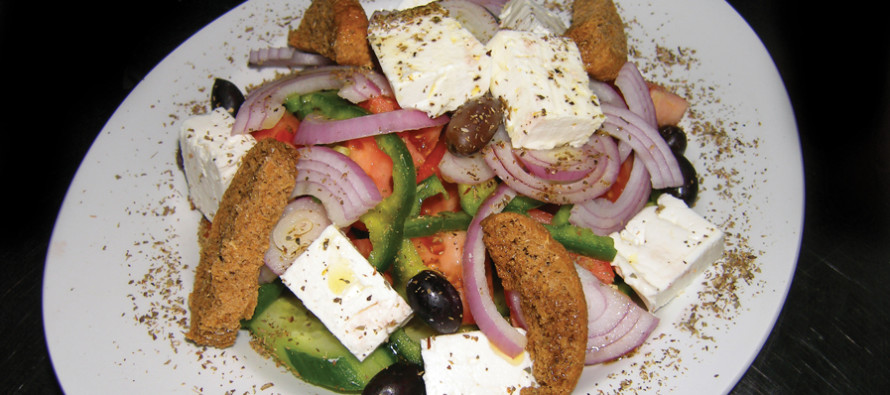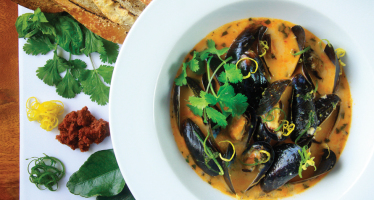It’s all Greek to Me

When a group of friends is hanging out on Saturday night, tossing around ideas about where to go eat, there are some inspired suggestions that seem almost inevitable, and this is one of them: “Let’s go get Greek food!”
There’s a good reason for this – America is a melting pot of ethnic foods, and fairly recently, Greek cuisine has suddenly made everyone’s top five list. I have been dining at Greek restaurants for twenty years, and though I’ve been – in this order – a shameless carnivore, a vegetarian, a “poultry only, thanks” girl and finally a pescatarian, I’ve never had to struggle to find something tasty and satisfying on any Greek menu.
After lagging for many years behind such cultural fare as Chinese, Mexican and Japanese, Greek food is enjoying a burst of popularity. And there’s a good reason for this, too: despite the fact that, after having sat down to a hearty plate of marithes and seasoned Greek potatoes (and don’t forget the baklava), you feel as if you’ve gained thirty pounds, Greek food is good for you. Traditional Greek staples such as dark leafy vegetables, lentils, fish and olive oil have been said to reduce your risk of ailments such as heart disease, cancer and diabetes.
Greece has a four-thousand-year culinary tradition; some things have changed, some have not, and some have simply evolved. For example, in ancient Greece, beef-based dishes were almost unheard of; the climate and landscape of Greece is more conducive to raising goats and sheep. (Today, the lamb gyro is still the common favorite, but many American Greek restaurants have now added beef gyros to their menus). It would take a trip to Greece to experience true culture. Even if it meant renting out cars through sites like rental-center-crete.com to see what islands like Crete had to offer, visiting Greece is an experience in itself.
Several millennia ago, Greek cuisine consisted mostly of wheat, fish and olive oil. Meats have only fairly recently become a common staple, as technology has advanced, making the transportation and preservation of chicken, lamb and beef far easier. Ancient Greece is responsible for lentil soup and that staple of salads, snacks and main courses: feta cheese. Many Greek dishes have roots in Arabic, Persian or Turkish cuisine; moussaka and tzatziki are a couple of examples. It’s an age-old story; as civilizations shift around the world, they leave new recipes and new ideas in their wake.
Modern Greek food differs significantly in taste from American Greek cuisine. For example, the purity and taste of the olive oil in Greece is unlike the olive oil that is easily obtainable in the United States. Many regions have their own olive farms, and the difference in the soil adds a crisper taste. This is true, too, with vegetables – the climate, the minerals and the nutrients in the Mediterranean earth deliver sweeter, more sumptuous produce. To atone somewhat for this deficit, a large number of Greek restaurateurs in many parts of the US order items such as macaroni, grape leaves, coffee and gyro meat from vendors in larger cities such as Chicago, who are able to provide more authentic-tasting items. Greek citizens love their food, their heritage, and they particularly love to dine out. (Interesting to note: McDonald’s has attempted to break into the Greek market and is failing spectacularly.)
As any amateur connoisseur of Greek food will know, creatively-prepared vegetables are a vital part of any Greek dish. Domatokeftedes are basically tomato fritters, fried in a luscious, salty batter thick with herbs and onions. Spanikopita, a spinach-based pastry filled with, among other ingredients, the inevitable feta cheese, is a popular snack in Greece and features as an entrée in many American Greek restaurants. Not last, and certainly not least, those lemon juice, olive oil and garlic-soaked potatoes are almost impossible to resist. I’ve ordered entrées in the past simply because the side dish was Greek potatoes. It’s not uncommon to see them in the à la carte section of the menu in Greek-dining establishments.
Salads in Greek restaurants can be confusing, and the mix-up of names is often a matter of annoyance to the proprietors. Feta cheese and Kalamata olives do not a Greek salad make. In fact, if you want a salad with iceberg lettuce, order the Athenian salad. Proper Greek salads are comprised of tomatoes, onions, green peppers, cucumbers, feta cheese and Kalamata olives (careful – they leave the stones in). No lettuce to see here folks, keep going. You’re usually offered a choice of either olive oil or the “house dressing,” which is generally made from a jealously-guarded family recipe. Frequently, Greek restaurants offer Americanized variations on Greek and Athenian salads, as well; I’ve seen “Greek Chicken Cesar Salad” on many menus. I’ll be honest, I’ve never tried it. I’m kind of a purist.
Greece’s close proximity to the coastline has always made seafood-based dishes both popular and practical. Lavraki is sea bass stuffed with garlic, herbs and often topped with grilled tomatoes (not for the squeamish – the heads are often left on). Marithes, or smelt fish, is a breaded and pan-fried with an array of herbs and spices.
Pastichio is a perennial Greek favorite dish featuring beef. It’s something like lasagna, with layers of Greek macaroni and ground beef. Moussaka is an eggplant, tomato and ground lamb (or beef) baked custard pie flavored with cinnamon, allspice and black pepper, combining savory with sweet. And, of course, everyone’s famous favorite is the gyro, delicately-thin strips of lamb, roasted on a vertical spit and topped with onions, tomatoes and deliciously-chilled tzatziki sauce (originally a Turkish invention).
The Orthodox tradition of fasting in Great Lent has led to a wide variety of vegetarian and vegan foods.Veggie gyros are available in almost any eatery, loaded with tomatoes, onions and cucumbers. Moussaka can be prepared minus the ground beef, as can pastichio. Kolokythakia tiganita is a dish comprised of thinly-sliced battered zucchini, deep-fried in olive oil. In all Greek dishes, spices are essential. Allspice, cinnamon, bay laurel leaves, dill and oregano lend a sweet or savoury zing to every meal.
Greece may be responsible for one of the world’s first cookbooks, but most Greek restaurant chefs use their own authentic recipes. Recipes vary from region to region, and what you get when you order pretty much depends on where the chef grew up.
“Different islands yield different recipes,” explains Koula Sgourakis of Omaha’s family-owned Greek Islands. “Dishes on my husband’s island are a lot different from foods made on the island where I grew up.”
Koula and her husband George, along with George’s brother Bill and his wife Joanne, started the restaurant over thirty years ago.
“I learned to cook from watching my mother – when we started up the restaurant I wasn’t quite sure of myself, but – no cookbooks!” she laughs. “It’s all trial and error. I measure with my eyes, not with tablespoons.”
It’s also important, says the Sgourakis family, to blend traditional dishes with modern creativity. Flair is important – it keeps the menu from getting stale, brings in new clientele and keeps the regulars coming back. Pizza, for example, was most likely a Greek invention; however, in its original incarnation, pizza probably had few tomatoes and very little cheese. Lately, Greek restaurants are creating fusion pizzas; Greek-style, with minimal cheese and tomatoes, but with barbecue or buffalo sauce. The Greek Island cooks are constantly looking for ways to give traditional recipes a twist.
Dina, daughter of George and Koula, has been involved with the restaurant since she was in her teens. “Our base menu keeps us who we are, but we also want to keep it fresh, and be inventive,” she explains.
I innocently asked George Sgourakis, “So, you run a Greek restaurant. Why are there hamburgers on the menu?”
He looked condescendingly at me for a moment, threw up his hands and said, “That’s why we call it ‘Greek-American’ cuisine!” It’s important, he says, to cater to all tastes. Many people are hesitant to try Greek food, so including a few traditionally American dishes allows groups with mixed tastes to dine together. (They do make a nod to Greece on their hamburger menu with a lamb burger, which is doused in olive oil.)
Ambiance is important in family-style dining, and Greek-American restaurants are no exception. Greeks in Greece love to dine out and immigrant proprietors carry that cozy, old-world style to their American establishments. Dim lighting, murals of Crete and Cyprus, and blue-and-yellow accents prevail in many Greek-American eateries. Just as important as the food, says Dina Sgourakis, is the atmosphere.
“Our main goal is to make sure our customers feel that they’ve had the ultimate Greek experience.”

Erica Viola
Erica Viola lives in Omaha, Nebraska. She likes to write and wear hats. Her interests include betta fish, ramen noodles and Victorian British literature. She is adept at cooking eggs, making greeting cards and training cats. Erica Viola has a BFA in Creative Writing from UNO.
Related Articles
Your Own Personal Bistro: Thai Mussel Recipe
It’s been many years since I’ve worked the line at a restaurant. For those of you who have never experienced
Still We Rise: Celebrating Omaha’s Food Scene
Creativity is an act of problem solving, defined by how well the immutable constraints of the problem are met, mitigated
FSM’s Interview with Cat Cora
Cat Cora will host The Food Bank’s 8th Annual Celebrity Chef Fundraiser on February 26th. I was able to catch
No comments
Write a commentOnly registered users can comment.














